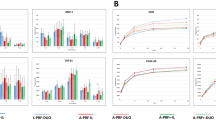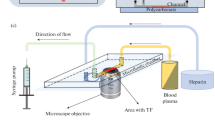Thrombus formation at an artificial surface in contact with blood is the result of the interplay of two tightly linked biological systems, namely blood platelets and blood coagulation. While initiation of the overall process is thought to originate from proenzyme-enzyme conversions at the artificial surface, propagation of the process is only possible when a suitable phospholipid surface is available. The outer leaflet of the plasma membrane of activated platelets is such a surface; it containts negatively charged phospholipids which are normally present in the inner leaflet of the membrane. An examination of the thrombogenicity of materials, therefore, should include a quantitative assay for procoagulant sites at an artificial surface. In the present study we have evaluated polymers, exposed to platelet-rich plasma, for their procoagulant properties by using two sets of assays. With the one set, markers of blood coagulation were assayed (recalcification time of platelet rich plasma and kallikrein-C1-Inhibitor complex formation) and with the other set the surfaces were analysed for platelet adherence and procoagulant sites utilising annexin V, which has a high affinity for negatively charged phopholipids. For the polymers, the fastest rate of contact activation, as determined from kallikrein-C1-Inhibitor generation, was found with polyethylene. In spite of that, the conventional partial thromboplastin time (PTT) could not reveal differences between the various materials. However, when clotting was performed with platelet-rich plasma, it was found that the polymers differed significantly in their clot promoting activities. The shortest clotting time (5 min) was found with polyethylene (PE), and polyvinyl chloride (PVC) gave the longest clotting time (10 min). These findings closely correlated with the amount of procoagulant sites generated at the platelet-rich plasma-polymer interface.
Similar content being viewed by others
References
J. Vermijlen, M. Verstraete and V. Fuster, J. Amer. Coll. Cardiol. 8 (1986) 2B.
E. M. Bevers, P. Comfurius, J. L. M. L.Van Rijn and H. C. Hemker, Eur. J. Biochem. 122 (1982) 429.
J. H. Chesebro, P. Zoldhelyi, L. Badimon and V. Fuster, Thromb. Haemostas. 66 (1991) 1.
S. Béguin, T. Lindhout and H. C. Hemker, Thromb. Haemostas. 60 (1989) 25.
J. H. Nuijens, C. C. M. Huijbregs, M. Cohen, G. O. Navis, A.De Vries, A. J. M. Eerenberg, J. C. Bakker and C. E. Hack, Thromb. Haemostas. 58 (1987) 778.
H. C. Hemker, G. M. Willems and S. Béguin, Thromb. Haemostas. 56 (1986) 9.
C. P. M. Reutelingsperger, G. Hornstra and H. C. Hemker, Eur. J. Biochem. 151 (1986) 625.
I. Maurer-Fogy, C. P. M. Reutelingsperger, J. Pieters, G. Bode, C. Stratowa and R. Hauptmann, Eur. J. Biochem. 174 (1988) 585.
G. Rollason and M. V. Sefton, J. Biomed. Mater. Res. 26 (1992) 675.
S. L. Goodman, T. G. Grasel, S. L. Cooper and R. M. Albrecht, J. Biomed. Mater. Res. 23 (1989) 105.
Author information
Authors and Affiliations
Rights and permissions
About this article
Cite this article
Lindhout, T., Blezer, R., Maassen, C. et al. Platelet procoagulant surface as an essential parameter for the in vitro evaluation of the blood compatibility of polymers. J Mater Sci: Mater Med 6, 367–372 (1995). https://doi.org/10.1007/BF00120306
Received:
Accepted:
Issue Date:
DOI: https://doi.org/10.1007/BF00120306




